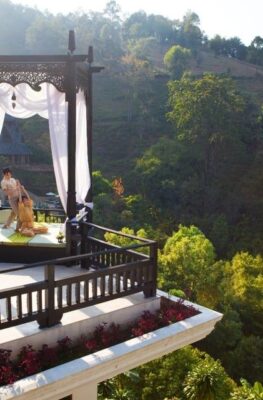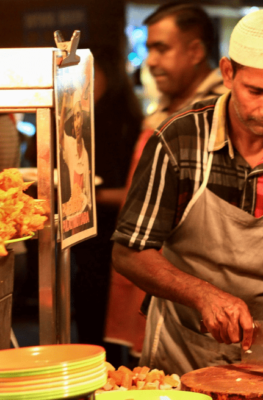Published on April 3, 2018
Young muay Thai practitioner in Thailand. Released to public domain.
For a grittier cultural experience in Southeast Asia, you can hardly do better than take up a local martial arts class. You won’t just be working up a sweat or absorbing punches or giving back as good as you get – you’ll be taking a unique history lesson as well.
“Martial arts have been a constant part of Southeast Asia’s history since the Angkor era in the 9th century,” explains Two Can Travel‘s Jen Joslin (Facebook|Pinterest|Instagram). “At that time Cambodia controlled many parts of the region, including much of Thailand, Vietnam and Laos.”
That, says Jen, is why many of Southeast Asia’s sports “[have] a lot of overlap,” the fighting styles of Jen’s preferred Khmer kickboxing bleeding into Thailand’s Muay Thai and Myanmar’s lethwei. Other martial arts disciplines – notably silat from the Malay realms – gave rise to popular martial arts like the Philippines’ arnis.
Thailand’s Muay Thai
The World Wai Kru Muay Thai Ceremony, Ayutthaya. Image courtesy of the Tourism Authority of Thailand.
When Bunch of Backpackers‘ Manouk Bob (Facebook|Twitter|Instagram) first heard about Thailand’s Muay Thai kickboxing sport, she associated it at first with “aggression and mindless fighting.” Only after watching an actual match did she find something different: “I discovered Muay Thai is actually a sport of ancient traditions, respect and control.”
On her latest trip to Thailand, Manouk dove deep into the sport: she “attended Muay Thai tournaments, met famous Muay Thai fighters (such as Buakaw) and even participated in the Wai Kru ceremony in Ayutthaya.” In the latter, Manouk joined hundreds of Muay Thai boxers from all over the world as they paid their respects to their teachers, and ultimately the legendary Muay Thai folk hero Nai Khanom Thom.
To complete the experience, Manouk joined a few muay thai training sessions in Kanchanaburi. “Muay Thai training is not only a great and fun work-out, but it also helps with your self-confidence,” she tells us. If you want to do as Manouk did, you’ll find Muay Thai schools spread out all over Thailand – just “ask around to see which schools are good and open to foreigners,” recommends Manouk.
Khmer fighters in Cambodia. Image courtesy of Robert Starkweather/Creative Commons
Khmer Kickboxing in Cambodia
Two Can Travel‘s Jen Joslin (Facebook|Pinterest|Instagram) wants you to know that “Khmer Kickboxing is every bit as entertaining and interesting.”
In Cambodia, the locals call kickboxing Pradal Serey, or “free fighting”: “the sport consists of four types of strikes: punches, kicks, elbows and knee strikes, with elbow strikes being the primary way to clinch a victory,” Jen explains.
“Fights are screened live on national television, and you can go watch a fight nearly every day in Phnom Penh,” she tells us. “Crowds can get rowdy and the energy inside the venues is electric, especially on weekends.” Jen suggests talking to the staff at Mad Monkey Hostel; they offer the latest information about local fights in Phnom Penh worth seeing.
And if you want to try it for yourself, Jen suggests “joining a drop in class at the Khmer Kickboxing gym Selepak Cambodia, located nearby the Tuol Sleng Genocide Museum in Phnom Penh.”
Lethwei match in Yangon, Myanmar. Image courtesy of Ric Gazarian.
Lethwei in Myanmar
For Ric Gazarian of Global Gaz (Facebook|Twitter|Youtube), the Myanmar martial art lethwei was a revelation.
“An elbow to the head. A knee to the abdomen. A head-butt to the bridge of the nose? Is this a back- alley street fight?” Ric asked himself when he watched his first match. “Lethwei is the more violent sibling of the similar fighting style [to Muay Thai].”
While Muay Thai is already considered vicious due to its use of elbows and knees, “Lethwei ups the ante adding head-butts into the fighter’s arsenal,” Ric explains. “Lethwei fighters in Myanmar also fight bare-knuckled with just a simple wrap on their hands (compared to boxing gloves in Thailand).
“Witnessing a Lethwei fight in Yangon is a very authentic experience,” Ric says. “There are no touts greeting foreigners at the entrance of the stadium. In fact, there will only be a handful of foreigners in the audience.
“Another traditional touch is that the ring girls are dressed in traditional Burmese style.”
Arnis in the Philippines
Arnis class in Rizal Park, Manila, Philippines. Image courtesy of Mike Aquino.
Everything Zany‘s Ryazan Tristram (Facebook|Instagram|Twitter) learned the Philippines’ national martial art in his formative years.
“Growing up in the Philippines gave me an opportunity to learn this local martial art as a part of self-defence, and it was integrated in to our school curriculum,” Ryazan tells us. “During our training, our master (Arnis teacher) taught us how to properly handle rattan sticks (yantok) that served as our defence instrument.
“Understanding the various techniques, skills and the defence key points of this arts is important to become a master of Arnis,” Ryazan explains.
Arnis and its related martial art kali has had a cultural renaissance as of late, appearing in Hollywood movies like the Bourne franchise.
“The greatest Filipino cultural export is kicking ass,” Filipino writer Jessica Zafra explained. “Before Jason Bourne went on to destroy scores of opponents in three global blockbusters, Filipino martial arts practitioners had commanded the respect of fighters from Hollywood to Russia.”
Ryazan concurs: “Arnis has now become recognised around the globe as one of the leading disciplines in martial arts,” he tells us. “Travellers around the world visit the Philippines to learn Arnis from the local masters.”





